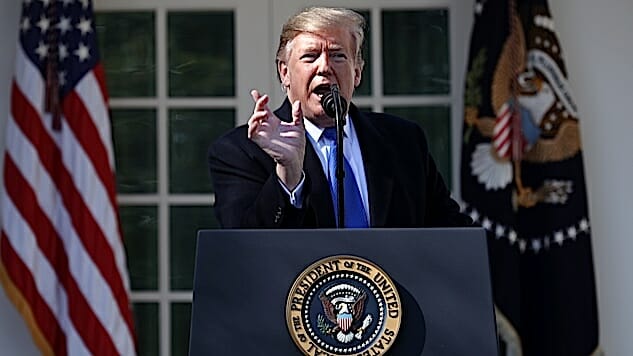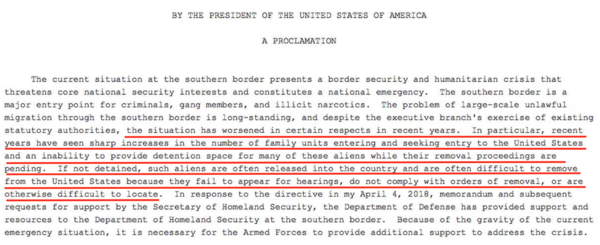Trump Just Delivered One of the Worst Press Conferences in U.S. Presidential History
Photo by Chip Somodevilla/Getty
This morning Donald Trump took to the Rose Garden to lay the groundwork for a declaration of a national emergency at our southern border. He instead turned in what will go down as one of the worst presidential rhetorical performances in the history of the United States.
Over the course of that 20-minute press conference, Trump claimed without evidence that Japan’s Prime Minister Shinzo Abe showed him a “beautiful five-page letter” nominating him for the Nobel Peace Prize, that Barack Obama told him in the Oval Office in November 2016 that he (Obama) was “so close to starting a big war with North Korea,” that his own government statistics about drug smuggling through legal ports of entry were “lies,” mocked Chinese President Xi Jinping’s English, spoke unprompted and at length about how talented Rush Limbaugh is because he can squawk for three hours without taking calls, lied for the millionth time that increased private income from the USMCA (the newly updated version of NAFTA, which still hasn’t passed Congress) would pay for his multibillion-dollar wall, exploited the grief of mothers of people killed by undocumented Americans by planting them in the audience and having them hold up a picture of their dead child, accused CNN correspondent Jim Acosta of asking a “fake question,” said the thing he’s “most excited” about in negotiating a trade deal with China is its use of the death penalty for drug dealers, and similar insultingly insane, offensive drivel.
It’s clear the president’s brain doesn’t seem to work in what you’d call a traditional way, and that begs its own coverage. But the premise for this particular press conference, however, was to justify Trump co-opting about eight billion dollars of congressionally allocated money to fulfill a campaign promise under the aegis of a national emergency. As of this writing Trump hasn’t signed the final papers giving the order, but the moment he does we can expect groups around the country—including Congress—to file lawsuits, because it just so happens he defeated his own argument.
It was so egregious, in fact, it seems he might be sabotaging himself intentionally. Here are the key moments:
“I didn’t need to do this.”
Most important is the moment where Trump says, “I didn’t need to do this. But I’d rather do it much faster…I just want to get it done faster.” So, okay, Exhibit A. Probably don’t even need an Exhibit B. But if you insist…
“We’ll end up in the Supreme Court.”
Trump described in great detail—literally by singing a song—how his declaration will have to travel a lengthy legal obstacle course before he can actually act on it.
And we will have a national emergency, and we will then be sued, and they will sue us in the 9th Circuit, even though it shouldn’t be there, and we will possibly get a bad ruling, and then we’ll get another bad ruling, and then we’ll end up in the Supreme Court, and hopefully we’ll get a fair shake and we’ll win in the Supreme Court.
Look, it’s counter-intuitive in the first place that Trump wants to solve an “emergency” by embarking on a long-term infrastructure project. But beyond that, he just publicly admitted that his own declaration of emergency will further delay that long-term project for months or even years. (An earlier lawsuit brought by a private U.S. citizen hung up barrier construction for seven years.) In fact, Trump even equated this declaration with his Muslim Ban: “Just like the ban, they sued us in the 9th Circuit and we lost, and then we lost in the appellate division, and then we went to the Supreme Court and we won.”
Yes, Trump ended up winning in the Supreme Court, but the Supreme Court found the first two versions of his executive order were unconstitutional. It took three revisions over nine months for it to pass.
So that’s Exhibit B: Trump admitting his own solution will make the “problem” worse—like pouring water into a pool while you’re trying to drain it.
“We’re declaring it for virtual invasion purposes, drugs, traffickers, and gangs.”
Here’s the only time Trump gives us a direct and specific national security reason for his national emergency declaration. However, this is at odds with the declaration itself.
First, Trump here specifies it’s not an invasion, but a “virtual” invasion. The constitution does say the United States will protect individual states against invasion, but, again, Trump did not call this an invasion. This might seem like a semantic difference—though in the eyes of the law it is not—until you look at the language of the order itself: No mention of invasion. So here Trump once more contradicts his own declaration. But that raises the natural question: What national security “emergency” does the order cite?
First, you might want to ask Trump how he feels about crime at the border. In 2009 he tried to build a resort south of the Mexican border—just a few miles outside Tijuana—right when violent drug-related crime at the border was peaking.
“Sharp increases in the number of family units.”
The declaration only mentions crime once, at the beginning: “The southern border is a major entry point for criminals, gang members, and illicit narcotics.” But the administration, knowing Trump’s claims about crime are lies that his own government statistics disprove, can’t use the decreases in crime to justify an emergency. Some facts, as provided by Trump’s own Customs and Border Patrol. NOTE: These stats aren’t even limited to those who enter illegally—it’s out of all “aliens” (ugh), including people here legally:
1. The number of people “convicted of one or more crimes, whether in the United States or abroad, prior to interdiction by the U.S. Border Patrol” has dropped by nearly half over the last two years. In 2016, it was 12,842. The next year, 8,531. And as of October 2018, that year CBP detained 6,259 such people. Each year more than half of those people were detained for crossing illegally, which Border Patrol lists as one of the crimes.
2. The total number of people detained in 2016 who had been convicted of homicides and manslaughter was eight. In 2017, it was three. As of October 2018, it was also three.
Also, illegal immigrants commit proportionally fewer crimes than other U.S. residents. And areas that have a higher concentration of illegal immigrants actually have less violent crime overall. Check the graph on the right:
#FACTCHECKINGTRUMP: Two charts demolish the notion that immigrants here illegally commit more crime. They don’t. https://t.co/411Uwb9nSQ#SOTU#GSPMSOTU#StateOfOurUnionpic.twitter.com/Hpx3RBTNAn
— (((AlanRosenblatt))) (@DrDigiPol) February 6, 2019
So the government’s own statistics force it to pivot to its only possible justification: The very real and ongoing administrative disaster at the border that has, combined with inhumane DOJ practices, led to a very real humanitarian crisis. Here’s what the order says:
That’s right: Not a spike in criminal apprehensions, or more dangerous criminals entering—a spike in families. Trump resorts to this because according to CBP stats, general southwest border apprehensions peaked in 2000 at 1.64 million and have dramatically and more or less steadily dropped since then, for a total of 396,579 apprehensions in 2018. However, there has been a spike in families seeking asylum. Trump, however, says the solution to this is not just in appropriating more money to deal with that problem, but in specifically appropriating more money to build a wall (and potentially deploy U.S. troops) to deal with that problem. Is a wall the most effective solution to processing the real emergency: An overworked and under-resourced administrative body?
Look, Trump is essentially arguing he needs to solve an emergency he created. After all, the recent administrative border crisis is 100% due to his new detention and deportation policies, which have all but broken the system.
“We’ve broken up two caravans that are on their way.”
FURTHER, in his press conference today Trump said, “We’ve broken up two caravans that are on their way. They just are breaking. They’re in the process of breaking up. We have another one that we haven’t been able to break up yet.” Those caravans are people seeking asylum in the United States. So first, this means his border patrol is doing just fine handling what he cites as an emergency without the wall in place. But in April 2018, the Trump administration released a memo that directed DHS and DOJ agencies to allocate more resources to building additional housing facilities for asylum seekers (i.e., families) so they didn’t have to go through, as Trump puts it, “catch and release.” What the administration realized, in other words, is that there are zero legal grounds to end catch-and-release beyond congressional legislation. The wall, of course, will have no impact on catch-and-release, because that process is almost entirely reserved for asylum-seekers (families) who would still show up to the ports of entry. And again, it’s the ports of entry that demand more administrative resources.
And finally:
“We have so much money, we don’t know what to do with it.”
Trump essentially admitted in his press conference he has more than enough resources for border security, going so stupidly far as to specifically include ample resources for ports of entry: “And in the bill, by the way, they didn’t even fight us on most of the stuff—ports of entry—we have so much money, we don’t know what to do with it. I don’t know what to do with all the money they’re giving us.”
So yeah, there’s no emergency at the border. The courts will rule against Trump unless and until he revises his declaration to focus on increasing administrative resources to process families—not to build a wall to fulfill his quixotic, xenophobic, unfulfillable campaign promise. Given he has no way out of the mess he’s made for himself, it’s not out of the realm of possibility that he’s doing this on purpose, knowing it will get rejected in the courts. Then, he bets, he can convince his base there’s someone else to blame—at which point we’ll finally find out who’s dumber: the president, or the people who elected him.








































